Imagine finally finding skilled professionals to bring your vision to life, only for them to deliver a final product that’s completely off the mark. Not only do you miss out on the expected cost savings, but you also lose valuable time and money and have to start over from scratch.
This is a common fear among many businesses. But how justified is it? And what can you do to avoid this and other IT outsourcing risks?
In this post, we’ll explore the key challenges companies may face when outsourcing IT projects. With over a decade of experience in the software outsourcing industry, we’ve encountered many of these fears and consistently dispelled them by delivering top-quality service.
We’ll also share survey data from reputable sources like Deloitte and Fieldfisher, highlighting how often these fears actually materialize. Finally, we’ll offer solutions to help you mitigate the common risks of IT outsourcing and maximize the chances of a successful partnership.
But first, let’s ensure we’re aligned on what IT outsourcing truly means.
What is IT outsourcing?
IT outsourcing involves contracting external service providers to handle IT functions, such as IT infrastructure, software development, and analytics. This strategy allows companies to focus on core business activities, reduce costs, and access specialized expertise.
Depending on the provider’s proximity to the client, IT outsourcing can be categorized into onshore, nearshore, and offshore outsourcing.
Types of IT outsourcing
- Onshore outsourcing means engaging services within the same country. It provides the easiest communication due to shared language and cultural understanding. There are no time zone issues, making collaboration seamless. However, it might be more expensive compared to nearshore and offshore options.
- Nearshore outsourcing refers to contracting companies in nearby or neighboring countries. It often offers similar time zones and cultural similarities, making communication relatively easy. Additionally, travel costs and times are low, facilitating smooth collaboration and oversight.
- Offshore outsourcing entails sourcing services to companies in distant countries, often across continents. This option offers significant cost savings due to lower labor costs. However, risks of offshoring may include time zone differences, language barriers, and cultural differences. When selecting this outsourcing type, ensuring effective communication and project management is crucial for smooth collaboration.
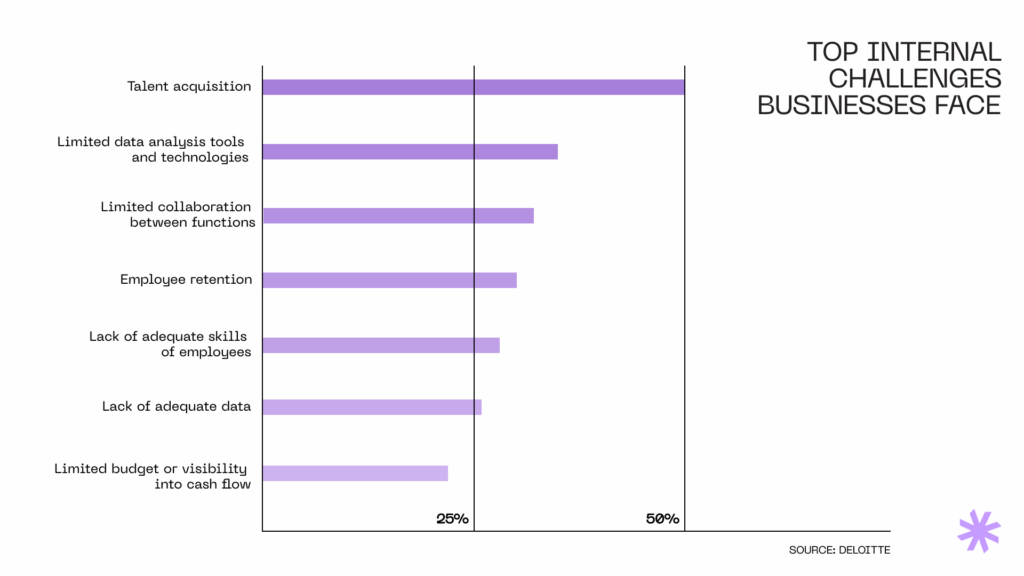
Top 4 benefits of outsourcing software development
According to a survey by Deloitte, US businesses most often outsource activities related to cybersecurity, software development, and IT infrastructure. But why is that? Well, these activities tend to demand the highest level of specialized skills and advanced technologies, which can be pricey and difficult to manage in-house.
Outsourcing tackles these issues by giving businesses access to a global pool of experts and top-notch capabilities from specialized providers. Plus, it promotes better collaboration between functions by integrating diverse expertise and streamlining processes, which boosts efficiency and sparks innovation.
Here are the top-reported benefits of IT outsourcing:
Fast time to market
By outsourcing IT functions, businesses can leverage the expertise and established processes of specialized outsourcing companies that can quickly ramp up resources and start projects. These vendors often have pre-existing frameworks, tools, and methodologies that speed up development cycles.
Cost savings
Outsourcing providers reduce costs through labor arbitrage by leveraging lower-cost labor markets. Using IT outsourcing services also eliminates expenses related to hiring, training, infrastructure, and overhead associated with maintaining an in-house team.
Access to global talent
Through outsourcing, you can get access to a vast pool of skilled professionals worldwide, allowing your business to tap into expertise not available locally. This global reach includes diverse technical skills and innovative solutions.
Flexibility
Outsourcing allows businesses to scale their IT resources up or down based on project demands without the constraints of long-term commitments. The outsourcing vendor’s ability to provide resources as needed enables this flexibility.
Take control of your software development
Don’t let the risks of outsourcing hold your business back. Contact Syndicode today to leverage our decade of experience in delivering top-quality, secure, and efficient IT outsourcing services.
Contact usTop common risks of IT outsourcing
Despite the considerable benefits of outsourcing, it can feel quite different from entrusting work to in-house employees.
The root cause of challenges in IT outsourcing primarily lies in the inherent distance and differences between the client and the vendor. This distance is not just geographical but also cultural, organizational, and communicational.
After all, outsourced developers are employed by another company and follow its policies and practices. They may have little interest in integrating with your core team or adhering to your company’s workflows.
So, here are the most common risks associated with IT outsourcing:
Loss of control
One of the greatest risks of outsourcing software development stems from the physical and organizational separation between the client and the vendor. Business owners might find it difficult to oversee the outsourced software development team’s work. This reduces their ability to monitor day-to-day activities, enforce standards, and make timely interventions.
As a result, being a client of an IT outsourcing services provider, you must rely on the vendor’s processes and management practices. Consequently, your influence over the project’s direction and quality may diminish, leading to a perceived or actual loss of control.
Hidden costs
Initial agreements may not cover all eventualities, leading to additional charges for changes, support, or unforeseen requirements. This risk of outsourcing usually arises from poorly defined contracts and scope creep.
Thus, software projects require regular meetings, updates, and check-ins to ensure all parties are aligned and working efficiently. They also require resources for continuous monitoring and testing to ensure the software product meets quality standards.
All of these factors pull additional time and costs. If the IT outsourcing services provider fails to correctly estimate these expenses, you’ll encounter additional charges in the development process.
Additionally, a lack of transparency in pricing models and communication can also contribute to unexpected expenses, complicating budget management.
Miscommunication
Another major risk of IT outsourcing stems from differences in language, time zones, and cultural expectations between the client and the outsourcing provider. These differences can lead to misunderstandings, misaligned goals, and unclear requirements.
Furthermore, inadequate communication channels and infrequent updates exacerbate the issue, resulting in errors, delays, and frustration on both sides.
Security concerns
When outsourcing IT activities, businesses share sensitive data and intellectual property with third-party vendors. This increases the risk of data breaches, unauthorized access, and non-compliance with security protocols, as control over security measures is relinquished.
Even worse, insufficient vetting of vendors’ data security practices and inadequate contractual safeguards can lead to potential data loss and IP rights violations.
Management issues
When outsourcing, you lose the ability to interact with diverse teams face-to-face. Therefore, coordinating across different time zones, maintaining consistent communication, and ensuring alignment with project goals and standards requires experience that many first-time clients of IT outsourcing vendors lack.
As a result, businesses often encounter inefficiencies, decreased morale, and suboptimal performance. All of these ultimately impact overall project success.
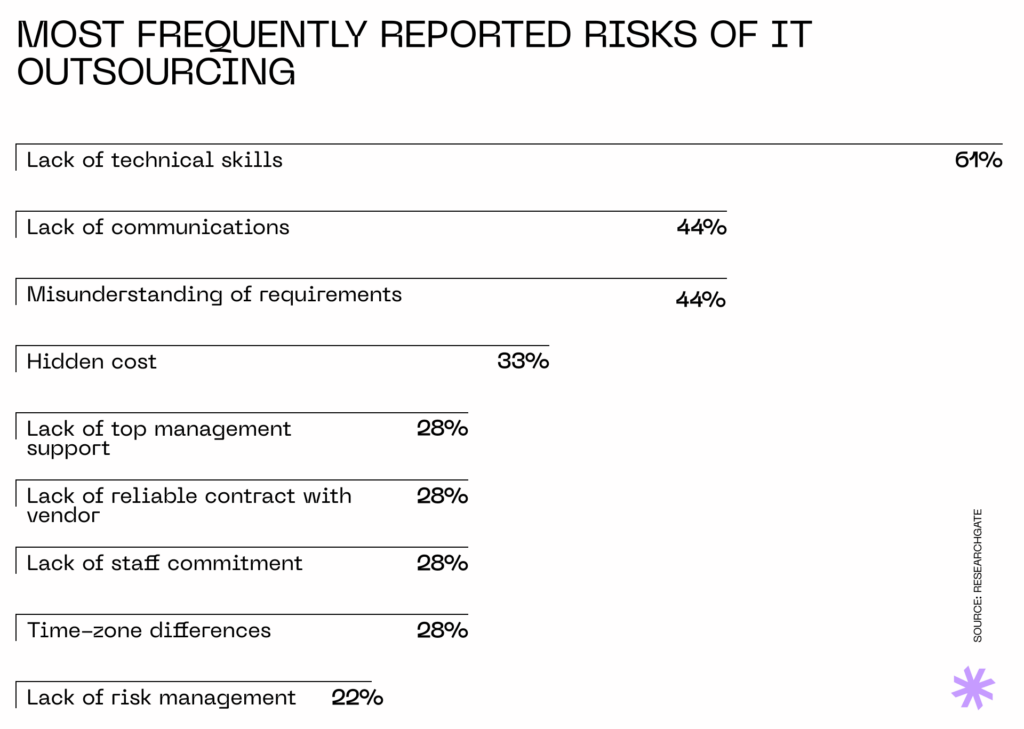
How to prevent the risks of outsourcing IT services?
If software outsourcing is that challenging, why do over 57% of businesses have at least one significant outsourcing contract? The good news is that all risks can be managed and mitigated.
Here are some tips:
Take back control
- Establish clear contracts
Setting defined terms, expectations, and deliverables in a contract creates a legal framework that serves as a reference point for resolving disputes, managing expectations, and enforcing accountability.
So, to avoid software outsourcing challenges linked to the lack of control over software development on the outsource, ensure your contract is comprehensive. It should outline the project scope, timelines, quality standards, and penalties for non-compliance.
This way, the third-party vendor can better understand their obligations and, therefore, provide better work quality.
- Define roles and responsibilities
It entails clearly outlining the specific duties and the chain of command of every team member, both in-house and outsourced. This clarity prevents overlap, confusion, and gaps in task ownership, leading to smoother collaboration and more efficient project execution.
By specifying who is responsible for what, businesses can maintain control over the project’s progress and avoid many problems of outsourcing. Clear roles also facilitate effective communication and decision-making, empowering the client to steer the project according to its objectives.
- Monitor progress
By regularly tracking milestones, deliverables, and overall performance against the agreed-upon schedule and quality standards, business owners can quickly spot deviations or issues. This allows them to step in promptly with feedback, adjustment requests, or escalate concerns, ensuring the project stays on track and giving the client a firm grasp on the outsourced development.
To mitigate this risk of IT outsourcing, invest time in selecting project management tools that you’re comfortable with and ensure all members of both the outsourced and in-house teams know how to use them. Popular software for managing outsourced IT projects includes Jira, Trello, and Asana.
Secure your IT projects with experts
Concerned about potential pitfalls in outsourcing? Syndicode has the expertise and proven track record to mitigate risks and ensure your project’s success. Reach out to us now and discover how we can safeguard your software development journey.
Let’s talkAvoid hidden costs
- Define the scope of work
Setting clear expectations for deliverables, timelines, and quality standards from the outset minimizes the risk of IT outsourcing associated with scope creep. It occurs when additional work or changes are requested without considering their impact on time and budget.
By establishing detailed requirements and boundaries, businesses can ensure that both parties have a shared understanding of the project scope. This reduces the likelihood of misunderstandings or unplanned expenses that could inflate the project’s overall cost.
- Select the relevant pricing model
Accurately assessing the project’s complexity and uncertainty and selecting a pricing model that aligns with these factors helps tailor the payment structure to the project’s specific needs. For instance, a fixed-price model offers cost predictability, while a time-and-materials model provides flexibility for projects with evolving requirements.
Engage in an open discussion with your IT outsourcing provider about your needs and expectations, and ask about the specific terms and conditions of their various engagement models. A thorough understanding of each model will help you manage your budget more effectively, avoid unexpected expenses, and ensure that costs remain aligned with the agreed-upon scope of work.
- Budget for contingencies
It’s impossible to foresee every challenge that might arise during an outsourced IT project. Even the most experienced and meticulous IT teams sometimes face changes in project requirements, unexpected technical issues, or delays.
By setting aside a portion of the budget to address the risks of IT outsourcing, businesses can absorb additional costs without jeopardizing the project’s financial stability. This proactive approach helps prevent cost overruns and ensures that the project can proceed smoothly, even when unexpected issues occur.
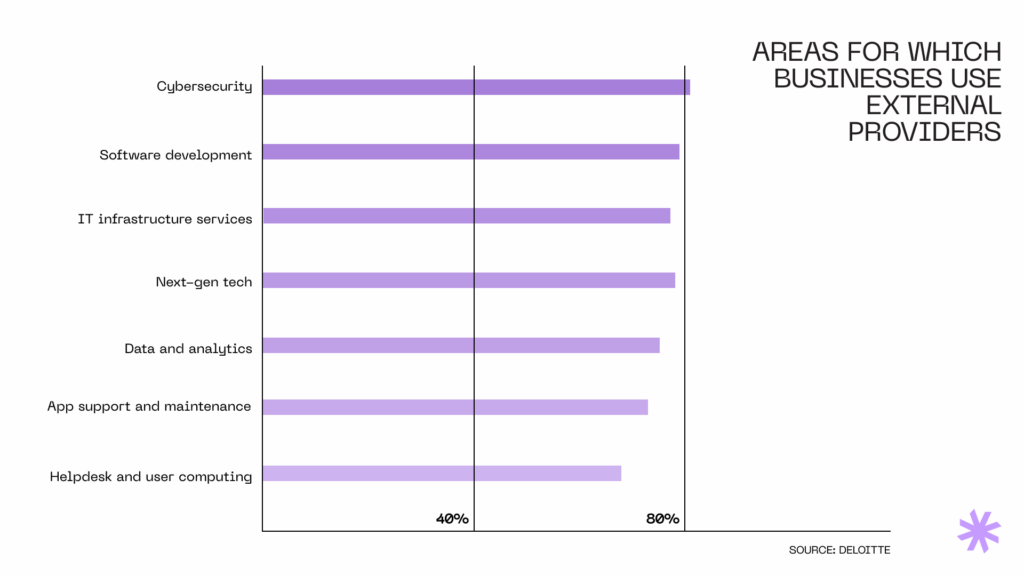
Ensure clear communication
- Choose effective communication channels
Many businesses highly value tools like Slack, Microsoft Teams, and Zoom for their accessible environments for information exchange, while others still prefer email. Additionally, some rely heavily on collaboration platforms like Confluence or Google Workspace to streamline document creation and sharing.
It’s crucial to choose tools that enable all project participants—both internal and external—to communicate efficiently, share updates, and resolve issues in real time. You might consider running a survey to gauge your team’s preferences and choose the most popular tool, or simply trust your instincts.
The key is to ensure that the selected tool facilitates clear and consistent communication, keeping everyone aligned on project goals, expectations, and progress.
- Schedule regular meetings
Consistent communication through regular meetings ensures that all stakeholders remain informed and engaged, promoting transparency and collaboration throughout the project lifecycle. This naturally mitigates many of the risks of IT outsourcing.
Consider scheduling weekly status updates or daily stand-ups to provide structured opportunities for teams to discuss progress, address challenges, and align on objectives.
These meetings create routine touchpoints where issues, questions, or changes can be openly discussed and clarified, reducing the risk of assumptions or misaligned expectations.
- Document everything
Well-organized documentation, including project plans, meeting minutes, and technical specifications, is essential for keeping everyone on the same page. These documents serve as vital reference points, ensuring a shared understanding of the project’s scope, objectives, and deliverables.
Additionally, maintaining clear and accessible records of project requirements, decisions, changes, and progress minimizes the risk of information gaps, forgotten details, or conflicting interpretations.
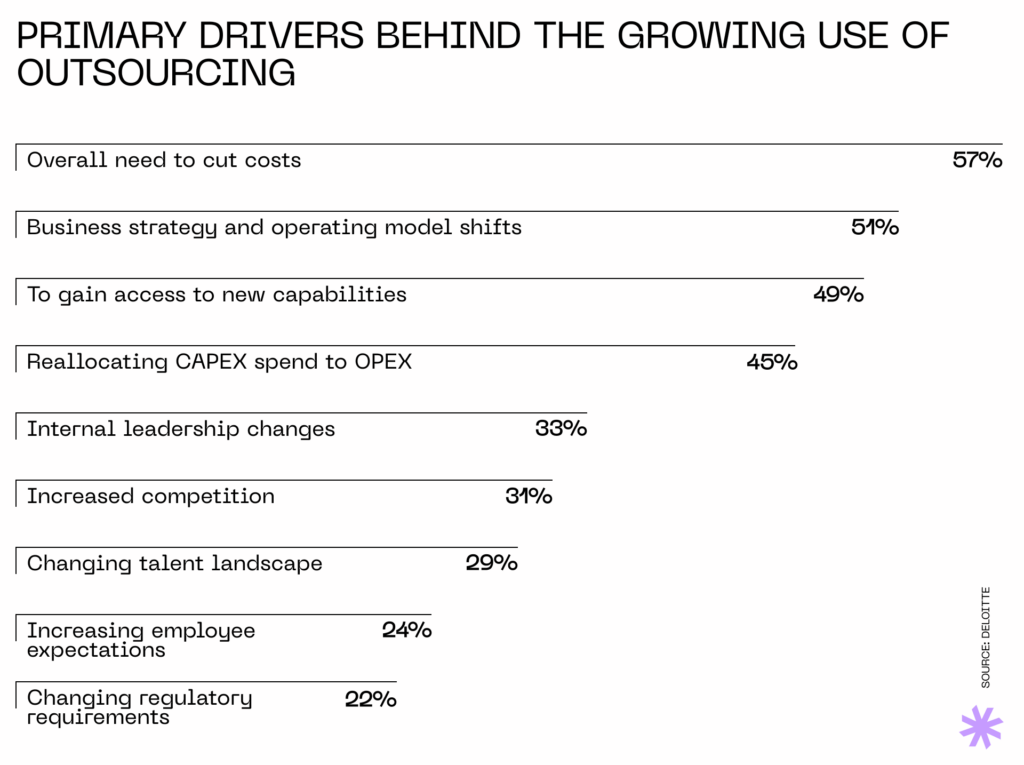
Prevent security issues
- Implement security policies
Establish clear guidelines and protocols for handling sensitive data and IT systems. These policies should define how data is accessed, transmitted, and stored, incorporating essential security measures like encryption, firewalls, and regular audits. This creates a robust framework for monitoring and addressing potential security threats throughout the project.
By taking this approach, you can enforce strict security practices with your outsourcing partner, minimizing the risk of security breaches, unauthorized access, or compliance violations.
- Sign an NDA
Signing a Non-Disclosure Agreement (NDA) helps mitigate security risks by legally binding the outsourcing partner to protect the confidentiality of sensitive information.
An NDA ensures that proprietary data, intellectual property, and trade secrets are not disclosed or misused by the vendor, creating a legal obligation for the third party to handle the client’s information securely.
By restricting unauthorized sharing, the NDA significantly reduces the risk of data leaks or misuse, protecting your business’s assets.
- Limit access
Implementing role-based access controls and adhering to the principle of least privilege allows businesses to restrict access to critical information, ensuring that only authorized personnel can access sensitive data and systems. This approach significantly reduces the risk of accidental or malicious breaches.
Limiting access also includes monitoring and regularly reviewing who has access, ensuring that permissions are granted only to those who need them to perform their specific tasks.
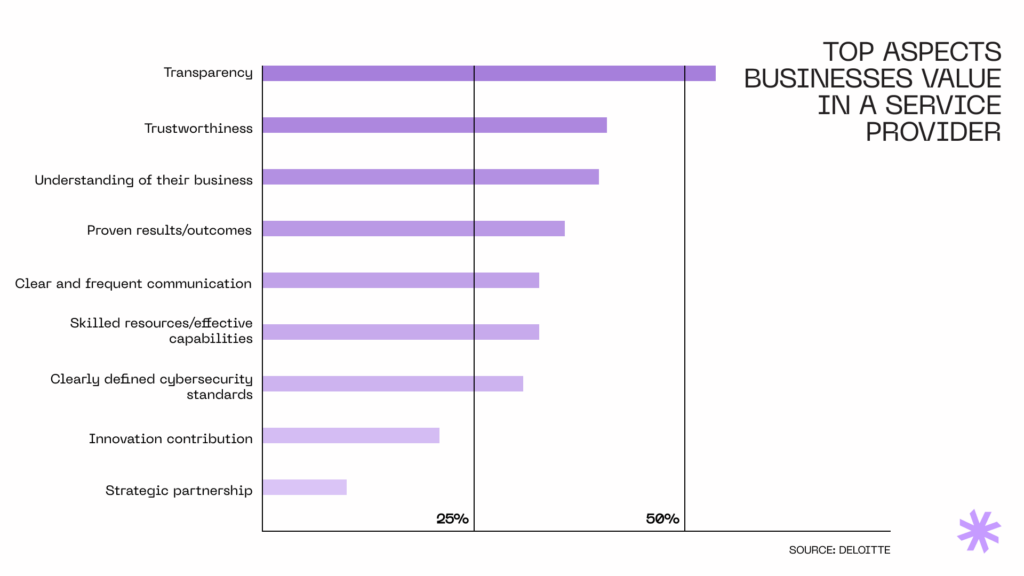
Simplify management
- Set clear and measurable project objectives
Clearly define your objectives and establish criteria to measure progress and success. Assess the available resources, time, and constraints to ensure that your goals are realistic. Finally, set a clear deadline or timeframe for achieving these objectives.
By doing so, you provide your external team with a well-defined roadmap and measurable goals, reducing ambiguity, facilitating decision-making, and improving the ability to track progress. When all team members understand what success looks like, it becomes easier to coordinate tasks, evaluate performance, and make necessary adjustments, leading to more efficient and effective project management.
- Create a risk management strategy
This strategy provides a structured approach for addressing risks related to timelines, quality, communication, and other project aspects, ensuring issues are managed effectively as they arise. To create it, collaborate with your team to identify potential challenges and develop strategies to mitigate them.
By anticipating and planning for risks, businesses can avoid disruptions, make informed decisions quickly, and maintain project momentum. This approach leads to smoother collaboration with the external team and fewer surprises throughout the project lifecycle.
- Hire a dedicated project manager
The project manager serves as the crucial link between the business and the outsourced team, ensuring clear communication, alignment with objectives, and adherence to timelines. They are responsible for monitoring progress, resolving issues, and keeping all stakeholders informed.
By having a project manager in place, businesses can delegate the daily management of the external team, freeing up internal resources and ensuring the project stays on track and meets its goals.
Maximize your project’s success
With our rigorous quality and security protocols, your software development is in good hands. Get in touch with us today to explore how our outsourcing services can boost your project’s efficiency and innovation.
Write usSyndicode’s approach to software outsourcing risk mitigation
Syndicode has been delivering IT services through the outsourcing model for over a decade, accumulating extensive experience across diverse environments, industries, and technological needs.
Here are the key factors that enable us to ensure the highest quality of services while mitigating the risks associated with IT outsourcing:
Experienced and skilled engineers
We follow a stringent hiring process that includes multiple rounds of interviews, technical assessments, and thorough background checks. This ensures that we hire only highly qualified and experienced professionals.
Additionally, we invest in ongoing training and professional development programs to keep our teams current with the latest technologies and industry practices.
Our outsourcing IT company also specializes in Ruby on Rails development and marketplace development and has recently expanded its AI & ML development department. This focus has allowed us to build deep expertise and offer highly skilled professionals in these areas.
Emphasis on quality and security
We implement rigorous QA processes, combining both automated and manual testing, to ensure that the software we develop meets high-quality standards and functions as intended.
Our specialists strictly adhere to industry-standard security protocols, including encryption, secure coding practices, and regular security audits, to safeguard client data and intellectual property.
We also follow international quality and security standards, such as ISO and GDPR, to ensure that our processes meet the highest quality standards.
Proven track record of successful projects
Our Featured Cases page showcases a portfolio of successful projects and case studies, highlighting our expertise across various industries and technologies. Among our recent projects, you’ll find:
- ThredUP, a prominent fashion resale platform in the USA. Through our rigorous hiring practices, focus on technical expertise, and industry experience, our team successfully managed this complex project, delivering impactful results that contributed to significant business growth and IPO success.
- Fuzu, a job marketplace tailored for African audiences. Our team adeptly handled this large-scale application, enabling it to support a growing user base and complex functionalities. We ensured that Fuzu efficiently connects job seekers and employers across African countries.
- Maxwell, a real estate investment platform that our engineers enhanced, improving user experiences and streamlining operations.
Final thoughts
Outsourcing can be an effective way to manage software development projects, especially when you have a trusted partner to help you navigate potential risks. Still worried about the challenges that come with IT outsourcing? Consider exploring IT staff augmentation with Syndicode instead.
As an experienced provider of outsourcing and staff augmentation services and a full-cycle software development company, Syndicode is uniquely positioned to help you leverage the benefits and minimize the risks of outsourcing. Our services are tailored to boost efficiency and drive innovation in your development projects.
Frequently asked questions
-
What is the difference between outsourcing and staff augmentation?
We have a detailed article that thoroughly compares the specifics of outsourcing and outstaffing models, so be sure to check it out. In brief, the key difference lies in project ownership and the level of external involvement. Outsourcing IT services involves contracting an external company to manage entire projects or business functions, offering end-to-end services, and taking full responsibility for delivering results. Outsourcing to a software development company allows businesses to focus on core activities while benefiting from external expertise. Staff augmentation, on the other hand, involves temporarily hiring external professionals to work alongside your in-house team. These external resources fill specific skill gaps or increase capacity for particular tasks, while overall project management and responsibility remain with the hiring company.
-
How to choose a reliable software development outsourcing vendor?
Choosing a reliable software development outsourcing firm involves thorough research and evaluation. Start by assessing the vendor’s experience and expertise in the relevant technology and industry. Check their portfolio for similar projects and client testimonials to gauge their reliability and quality of work. It’s crucial to evaluate their communication skills and project management practices to ensure smooth collaboration. Additionally, consider their security protocols and compliance with industry standards to protect your data. Finally, review their pricing model and contractual terms to ensure transparency and alignment with your budget and project goals. Being steady and meticulous in your research will help you avoid many of the common software outsourcing challenges.
-
How does Syndicode prevent risks associated with IT outsourcing?
Syndicode approaches IT outsourcing risk mitigation through robust project management practices, which include establishing clear communication channels and defining roles and responsibilities from the outset. First, we create detailed contracts that clearly outline the project scope, timelines, and expectations to prevent misunderstandings. We also implement regular monitoring and reporting processes to track progress and swiftly address any issues that arise. Our stringent security measures, including data protection protocols and compliance with industry standards, ensure the safeguarding of sensitive information. Moreover, we strive to be more than just a service provider—we aim to be a reliable development partner dedicated to helping clients achieve their business goals. By aligning our technical expertise with our clients’ strategic objectives, we deliver customized solutions that enhance operational efficiency, reduce costs, and accelerate time-to-market for products and services. This approach allows our clients to focus on their core business activities while we manage the complex technical tasks.
-
What are the best countries for software development outsourcing?
The best countries for outsourcing to a software development company are those with a strong pool of skilled IT professionals, competitive costs, and favorable business environments. As of now, countries like India and Ukraine are well-known for their large talent pools and cost-effective services, making them popular choices. Poland and Romania offer a combination of high-quality work, proximity to Western Europe, and strong technical education systems. The Philippines is recognized for its English proficiency and cultural compatibility with Western clients. Vietnam and Brazil are also emerging as attractive destinations due to their growing tech industries and competitive pricing.
